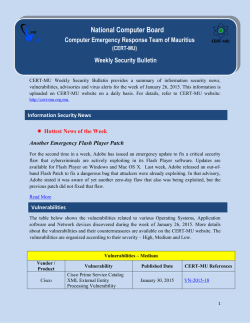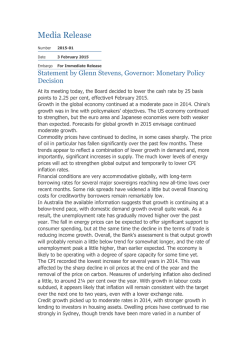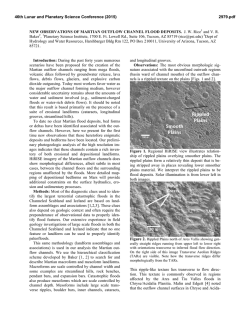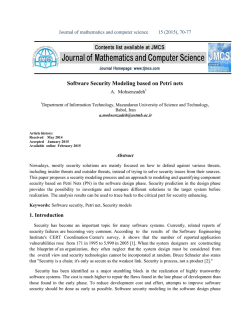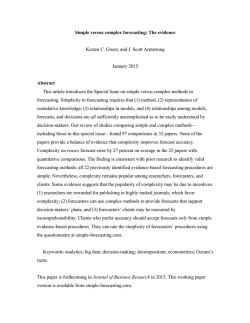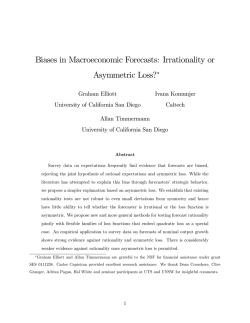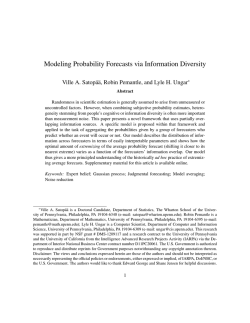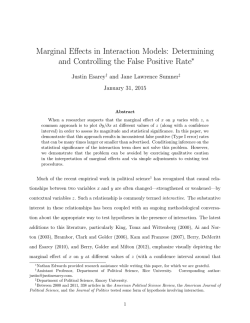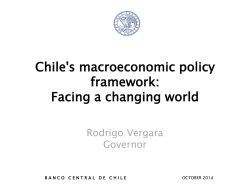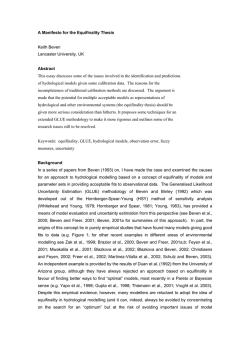
View announcement [PDF 708.48 kB]
World Meteorological Day 23 March 2015 2 Climate knowledge for climate action Weather forecasts have been a part of everyday life since the mid twentieth century. Before going to work or school, people check the weather in order to know how to dress and how to keep safe. Weather forecasts help farmers, emergency workers and other decisionmakers in weather-sensitive sectors to schedule their daily and weekly work priorities. These forecasts are becoming ever more reliable – today’s five-day weather forecast is as good as the two-day forecast of 25 years ago – thanks to advances in weather and climate science and in computing power. Researchers are using improved observations and greater computing power to study and predict natural cycles and broader patterns in the climate system. As a result, they can provide increasingly useful seasonal climate predictions. For example, they can assess the probability that the next season will be hotter or wetter than usual. Weather and climate predictions for the next month, the coming monsoon or growing season, or the next El Niño/Southern Oscillation event will become more and more reliable and useful over the coming years. In addition to greater knowledge about natural climate variability, scientists have made enormous progress in understanding how humanity’s greenhouse gas emissions are changing the climate. Drawing on climate science and scenarios of greenhouse gas concentrations, they can project how the climate will change, and they can assess vulnerabilities and likely impacts in specific regions. This knowledge is invaluable for longer-term planning. Delivering and using knowledge Global Framework for Climate Services While the science progresses every year, a great deal is also being learned about how to help decisionmakers understand and apply climate knowledge. This enables the providers of weather and climate knowledge to develop and offer customized information for a wide range of users. They are building partnerships with decisionmakers and communities to develop and deliver reports, graphics and other information products that these users can understand and use as a basis for action. Each user has different needs for particular types of climate knowledge and the language, frequency and format in which it is delivered. The Global Framework for Climate Services (GFCS) is building a solid climate knowledge base for climate action at both country and community level. Spearheaded by the World Meteorological Organization, the GFCS is an international partnership for strengthening the provision of reliable, science-based climate services to support sustainable development and build climate resilience. For example, public health authorities may want to use forecasts of how the intensity and frequency of droughts, heatwaves and floods will evolve in the coming months and years to ensure that medical services and supplies are available where and when needed. They may be concerned that lower-than-average rainfall will increase the risk of nutritional and respiratory problems, while above-average rainfall may lead to outbreaks of vector-borne diseases such as malaria or waterborne diseases such as cholera. Weather and climate information can be integrated with maps showing population densities and the location of hospitals and transport systems to support the timely roll-out of vaccines ahead of a disease outbreak. In the longer term, knowledge about the anticipated intensity and frequency of droughts, heatwaves and floods can be used to shape the planning of medical and emergency services. Until recently, interaction bet ween the health and climate communities was rare. That is changing. The World Meteorological Organization and the World Health Organization are working together to bridge the gap and ensure that climate information is mainstreamed into health planning at both the international and national levels. Training The challenges of weather extremes and climate change transcend national boundaries. The GFCS promotes international collaboration, the pooling of resources and the sharing of best practices in order to build capacity, especially in the 70 developing countries that lack the resources and expertise they need for their citizens to benefit from climate services. The GFCS provides a platform for dialogue between national weather services and other knowledge providers on the one side, and policymakers and other users of weather and climate knowledge on the other. This ensures that climate services are relevant and accessible, especially to users in priority climate-sensitive sectors such as agriculture, water management, public health, energy and disaster risk reduction. workshops in countries such as the United Republic of Tanzania and Malawi are helping health professionals interpret and use meteorological data to improve public health. Climate knowledge is benefiting many other climatesensitive sectors as well. Farmers are using information and predictions about temperature trends and the onset of the rains to decide well in advance what crops to plant and when to irrigate or harvest. For agricultural policymakers, a monsoon forecast plus information on past cropping decisions and market trends can support decisions on food security. Meanwhile, water managers analyse climate information in order to estimate available water supplies and the need for new infrastructure. And so on. The future of decisionmaking Traditional weather reports offer valuable tactical information, but climate knowledge can be used to guide strategies and long-term plans for building climate resilience, reducing disaster risks and managing the farming, health, transport, energy, water and other vital systems that we all depend on. This revolution in climate knowledge is just beginning. In five to 10 years people will become just as familiar with using climate predictions as they are with weather forecasts. Imagine it is 2025 and you are a city planner responsible for ensuring that your community is resilient in the face of changing climate conditions. You must develop plans for building codes, water management, sewage, traffic and emergency preparedness that will remain effective for decades to come. Fortunately, you now have access to good-quality, credible scientific predictions and information on how seasonal and even multi-year variations in the climate may affect averages and extremes in temperatures, precipitation and wind – fine-tuned for your region. You can combine this climate information with maps and data on demography, economics, land-use change, topography, medical infrastructure, hydrology and more to inform the specific actions you need to take. In addition, you may wish to explore climate change scenarios in order to assess potential risks and vulnerabilities in future decades. By integrating long-term climate projections directly into impact assessments, you can estimate the risk that future storms will cause power outages (for example, by combining data on climate conditions with information on patterns of energy use), or you can assess how a long-term trend towards more droughts or floods will affect energy resources and infrastructure requirements. You may also use this knowledge to take action on reducing greenhouse gas emissions, for example, by rationalizing energy consumption through the optimal timing of renewables production and allocating resources more precisely for agriculture, construction and transport. Empowered by weather and climate knowledge, decisionmakers will have increasing confidence in their ability to take effective climate action. They will further reduce the risks of disasters caused by climate variability through integrated assessments of vulnerabilities, potential impacts and early warning systems. They will predict and respond more effectively to climate fluctuations that affect food security, public health, water resources and other climate-sensitive sectors. They will also use climate-change scenarios based on increasingly robust and high-resolution models to build climate resilience, address the particular vulnerabilities of women and children, and make decisions on land use, coastal management, and roads and other infrastructure. The benefits of an informed response to climate variability and change are huge: lives saved, livelihoods protected, property secured, negative impacts minimized and opportunities maximized. Today we have more weather and climate knowledge than ever before. Ignorance is no longer an excuse for not taking steps to minimize climate risks. Effective climate action can ensure human well-being today and through the rest of the twenty-first century. For more information, please contact: World Meteorological Organization Communications and Public Affairs Office Tel: +41 (0) 22 730 83 14 – Fax: +41 (0) 22 730 80 27 E-mail: [email protected] www.wmo.int JN 142501 7 bis, avenue de la Paix – P.O. Box 2300 – CH 1211 Geneva 2 – Switzerland
© Copyright 2025
